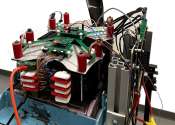Last update
Electronics & Semiconductors
Shape-morphing brain sensor adheres to curved surfaces for ultrasound neurostimulation
Transcranial focused ultrasound, a non-invasive technique to stimulate specific areas of the brain using high-frequency sound waves, could be a promising treatment strategy for many neurological disorders. Most notably, it ...
7 hours ago
0
47
Engineering
Scientists develop novel digital encoding system using fluorescent pixels
A team of scientists has developed a novel digital encoding and data storage system based on a combination of microcapsules containing different luminescent dyes and phase change materials. This work represents an important ...
7 hours ago
0
17

LiDAR-based system allows unmanned aerial vehicle team to rapidly reconstruct environments
Unmanned aerial vehicles (UAVs), commonly known as drones, have proved to be highly effective systems for monitoring and exploring environments. These autonomous flying robots could also be used to create detailed maps and ...

Study highlights complex ocean conditions facing world's most powerful tidal turbine
The number of tidal power and other offshore renewable energy installations is set to grow significantly around the UK coastline over the coming decades.
10 hours ago
0
28

As LLMs grow bigger, they're more likely to give wrong answers than admit ignorance
A team of AI researchers at Universitat Politècnica de València, in Spain, has found that as popular LLMs (Large Language Models) grow larger and more sophisticated, they become less likely to admit to a user that they ...
Energy & Green Tech
Organic supramolecular crystals with high hydrogen storage performance could enhance fuel-cell vehicle efficiency
Hydrogen is often seen as the fuel of the future on account of its zero-emission and high gravimetric energy density, meaning it stores more energy per unit of mass compared to gasoline. Its low volumetric density, however, ...
11 hours ago
0
90
Energy & Green Tech
Untapped potential: Study shows how water systems can help accelerate renewable energy adoption
Stanford-led research reveals how water systems, from desalination plants to wastewater treatment facilities, could help make renewable energy more affordable and dependable. The study, published Sept. 27 in Nature Water, ...
16 hours ago
0
18
Business

Clean energy transition: The impact of financial costs on the development of renewable energy sources
It is widely recognized that finance is one of the critical enablers of accelerating climate action. However, renewable energy deployment (particularly in developing countries) requires more financing than fossil fuel-based ...
11 hours ago
0
23
Computer Sciences

Computing scheme accelerates machine learning while improving energy efficiency of traditional data operations
Artificial intelligence (AI) models like ChatGPT run on algorithms and have great appetites for data, which they process through machine learning, but what about the limits of their data-processing abilities? Researchers ...
Sep 26, 2024
0
55
Energy & Green Tech

New continuous reaction process can help turn plant waste into sustainable aviation fuel
Washington State University scientists successfully tested a new way to produce sustainable jet fuel from lignin-based agricultural waste. Published in the journal Fuel Processing Technology, the team's research demonstrated ...
Sep 26, 2024
0
56
Energy & Green Tech

New tandem solar cells break efficiency record—they could eventually supercharge how we get energy from the sun
The sight of solar panels installed on rooftops and large energy farms has become commonplace in many regions around the world. Even in gray and rainy UK, solar power is becoming a major player in electricity generation.
Sep 26, 2024
0
75
Engineering

Enhancing semiconductor functionality with TeSeO materials for future electronics
In most inorganic semiconductors, electrons serve as the primary charge carriers, which limits the development of complementary devices and circuits. A recent study by City University of Hong Kong (CityUHK) researchers has ...
Sep 26, 2024
0
22
Engineering

New study shows AI can forecast mining disasters
Artificial Intelligence can forecast gas-related incidents in coal mines within half an hour, according to a new study exploring how the technology can reduce the risk of disasters.
Sep 26, 2024
0
29
Engineering

Bubbling up: Uncovering melt pool dynamics in metal manufacturing
Manually shaking or vibrating molten metal using ultrasonic waves helps reduce air bubbles, cracks and grain sizes in a finished metal part. Metal 3D printing researchers hypothesized that vibrations were the key to increasing ...
Sep 26, 2024
0
9
Electronics & Semiconductors

From quantum to wireless: Enhancing chip-scale communication with terahertz tech
As computing technology advances, we have shifted from using large, single-chip processors to systems made up of smaller, specialized chips called "chiplets." These chiplets work together to boost processing power and efficiency.
Consumer & Gadgets

ChatGPT's rise linked to decline in public knowledge sharing on online Q&A platforms
A new study published in PNAS Nexus reveals that the widespread adoption of large language models (LLMs), such as ChatGPT, has led to a significant decline in public knowledge sharing on platforms like Stack Overflow. The ...
Sep 25, 2024
0
33
Engineering

Unique straining affects phase transformations in silicon, a material vital for electronics
When Valery Levitas left Europe in 1999, he packed up a rotational diamond anvil cell and brought it to the United States. He and the researchers in his group are still using a much-advanced version of that pressing, twisting ...
Sep 25, 2024
0
45







































